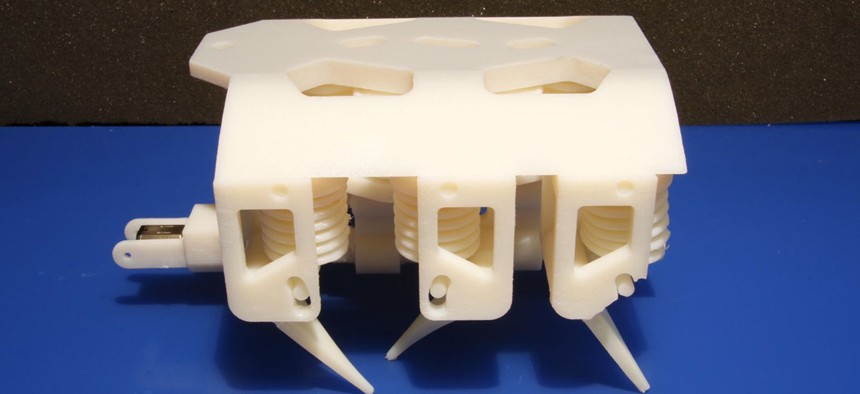MIT Scientists Create Hydraulic Robot from Single 3-D Print

MIT CSAIL
The robots are made up of solid and liquid parts, which could have big implications on how we design robots to interact with humans in the future.
We’re getting to the point where 3-D printing is slowly becoming useful. Earlier this week, Stratasys, the largest 3-D printer manufacturer, showed off new technology that can print full objects in one go, without any assembly required.
On April 6, researchers at MIT’s CSAIL computer science lab announced that they can print working robots on one 3-D printer, from a single print. The robots, which need to be hooked up to a battery source, are made up of solid and liquid parts, which could have big implications on how we design robots to interact with humans in the future.
The lab’s printer can print eight different materials at once, allowing it to create liquid-filled tubes that can be used to actuate robots’ joints. The different heads can emit solids, while others lay down liquids. Using special UV lights that cure the solid materials as they print—but leaving the liquids alone—the printer can accurately print complex structures with varied physical properties. A video produced by MIT shows a hydraulic valve that it built to pump liquids, as well as a roughly six-pound robot with complicated moving parts.
“Our approach, which we call ‘Printable Hydraulics,’ is a step towards the rapid fabrication of functional machines,” said Daniela Rus, lab director, and member of the new billion-dollar Toyota robotics research lab, in a release. “All you have to do is stick in a battery and motor, and you have a robot that can practically walk right out of the printer.”
The lab’s robot has built-in “bellows” that were printed inside it which use fluid pressure that enables it to move. MIT also showed that it could use this same concept to make soft, grippy hands for robots, which it installed on a Baxter robot, produced by Rethink Robotics. Using the liquid-filled fingers, the bot was able to deftly pick up an egg without damaging it.
While MIT and others have been working on robots that won’t crush us if we interact with them, the process to create them hasn’t been this easy previously. Obviously, MIT’s little six-legged robot isn’t quite as complex as C-3PO, or even a Roomba, but it does hint at one potential future of robotics: We’re approaching the point where we could print a robot that we could safely use in our homes.
Hopefully, however, if robots ever take over, they won’t realize that they can now easily print off fully functional versions of themselves on MIT’s new machine. Otherwise this lab in Massachusetts has likely doomed us all.


